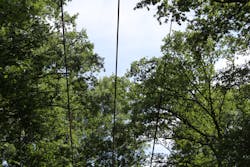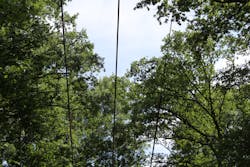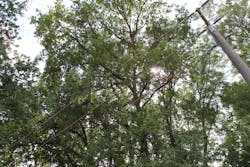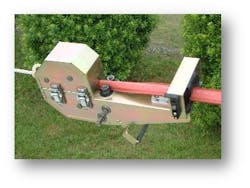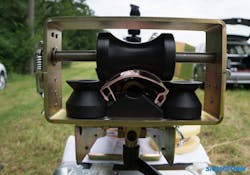Protecting Overhead Power Lines from Vegetation Clashing
All over the world, electric utility owners and operators are in a constant battle with Mother Nature. Trees, vines and shrubs growing near exposed overhead power lines and substations, electrical railway networks and other critical assets create an ever-present risk of conductor clashing, fire and wildfires and power outages. Despite facing fixed budgets, utility operators and owners typically spend millions of dollars/euros on time- and labor-intensive branch pruning and tree removal to manage vegetation that imperils the safe and reliable operation of these overhead power lines to ensure uninterrupted service.
In certain regions, companies face resistance from communities (for aesthetic reasons) when it comes to tree or branch cutting. In other regions, specific forested areas may include trees that are protected species, with local environmental-preservation regulations limiting branch trimming and prohibiting tree removal. Meanwhile, other regions may just be too remote to allow for cost-effective management of vegetation that threaten the overall power-distribution grid.
Protecting Endangered Tree Species
The Corsier/Anieres district around Geneva, Switzerland, is relatively flat and covered with small forests, many of which include trees that are protected by local environmental conservation laws restricting branch cutting and tree felling. A large portion of the overhead electrical network in this region belongs to Swiss utility, which operates a large number of medium-voltage (19 kV) electrical power lines initially built with bare (non-insulated) conductors. Since these power lines run through these forested areas, windy conditions have created persistent risk — causing tree branches to strike the conductors frequently, incinerating the branches and creating phase-to-phase outages interrupting reliable power distribution to the public.
The Swiss utility recently partnered with TE Connectivity and Sigmaform Switzerland, its regional distributor, sales and installation partner, to address these threats to its overhead power-distribution infrastructure in and around Geneva. Unable to trim branches or cut down trees in the region due to local conservation laws, the stakeholders instead turned to TE Connectivity and installed an engineered solution — the TE Raychem flame-retardant medium-voltage line cover (MVLC), which is part of the company’s broader Wildlife and Asset Protection (WAP) product portfolio. The company developed the product to provide electric utilities with a cold-applied system for improving flashover protection for bare medium-voltage (15-25 kV) overhead conductors.
The shrouding is manufactured from proprietary cross-linked Raychem materials. These polymers are formulated to provide tracking and erosion resistance, resistance to ultraviolet damage and thermal endurance in extremely high and extremely low temperatures. Coupled with their resistance to chemical and abrasion damage, their inherent flame retardancy and other performance characteristics, these Raychem materials allow the MVLC covers to provide protection in harsh outdoor environments and resist a wide variety of commonly encountered aging effects that can occur under normal service conditions. As a result, the covers have a 30-year installed service life.
Once installed, these polymer covers are able to safeguard exposed electric-distribution lines without conductor replacement or the need for additional line hardware, and without the need to disturb the protected species of trees nearby. Installation of extra-long spans of the MVLC, and spans that have an unusually long inter-distance of 120 m (393 ft) is helping to protect the overhead power lines against damaging interactions with nearby vegetation and eliminate conductor clashing.
With this new engineered solution, the Swiss utility has been able to selectively install the MVLC covers on the most at-risk spans of its overhead power-distribution infrastructure and thus reduce its overall maintenance program (carrying out sanctioned trimming of nearby branches just once a year, rather than twice per year).
This provides savings in two ways:
- Direct savings from reduced vegetation-management efforts, and
- Indirect savings by eliminating vegetation-related power disruptions or other costly unplanned maintenance and repair events
Installing the Covers
Most existing overhead power lines have conductors made from bare metal. When vegetation comes in contact with these live conductors, it can produce phase-to-ground or phase-to-phase flashovers. Such episodes can damage the infrastructure, lead to system failures and interruptions in power distribution and can initiate wildfires in the region.
While the use of insulated conductors, or the ability to bury power lines, provides an option for reducing risk from nearby vegetation, these options are not practical in many locations that already have existing bare-metal conductors in operation. This remains a challenge all over the world — it is simply not practical or economically feasible to take down and replace sections of bare-metal conductors with insulated conductors in areas where vegetation presents a persistent threat.
By installing conductor covers, utilities can provide shrouding on selective segments, which are most directly impacted, to protect critical assets. The MVLC product is extruded in continuous lengths, which are supplied on spools. The shrouding is available in three different sizes to cover conductors with diameters of up to 14-mm dia. (.55 in), 18-mm dia. (0.71 in) and 38-mm diameter (1.5 in).
The ability to install this protective shrouding in the longest-possible single segment helps installers to streamline the overall installation by minimizing the number of joints. By using specialized tools, specifically designed for line covers, they can further expedite installation. These tools attach directly to the overhead conductor and remain stationary in a single location on each span. Installers can operate the tool manually by using a hand crank or automatically with the use of high torque powered drill. Once in place, the MVLC shrouding remains stationary on each span.
For the installation in Geneva, the Sigmaform Switzerland team installed the covers in just a day. The overhead span of 20 kV electrical-distribution line requiring protection was 128 m (420 ft) long, and the MVLC was provided in one continuous length with a diameter of 18 mm (0.71 in). Using the automatic tool to install it, the entire span was installed at a rate of about 20 m/minute, (66 ft/minute). Once installed, these polymeric coverings require no ongoing maintenance or upkeep.
Since this installation was completed in 2017, the utility that operates the electrical power-distribution system in Geneva has reduced its overall vegetation-management budget by half and has reported no flashover or power-outage issues related to vegetation. And more importantly, the utility operators have been able to balance both the electrical demands and ecological requirements of the region by adopting and implementing environmentally safe initiatives.
Matthew James is the product specialist for Wildlife and Asset Protection at TE Connectivity. With almost 10 years of experience in both product management and materials engineering, James has driven innovations in material and product design across utility and industrial applications globally. He holds a Master’s degree in Integrated Engineering from the University of Bath with extensive knowledge and experience of polymer science and product design.
M. Alexandre Ortelli is the technical and sales support officer at Sigmaform Switzerland for LV/MV cable accessories. Ortelli has a bachelor degree in mechanical engineering from the Technical School (ETM) of Geneva, 1989. Having over seven years’ experience in product development, technical design and field installation supporting utility customers in the West of Switzerland.
About the Author
Matthew James
TE Connectivity
Alexandre Ortelli
SIGMAFORM
